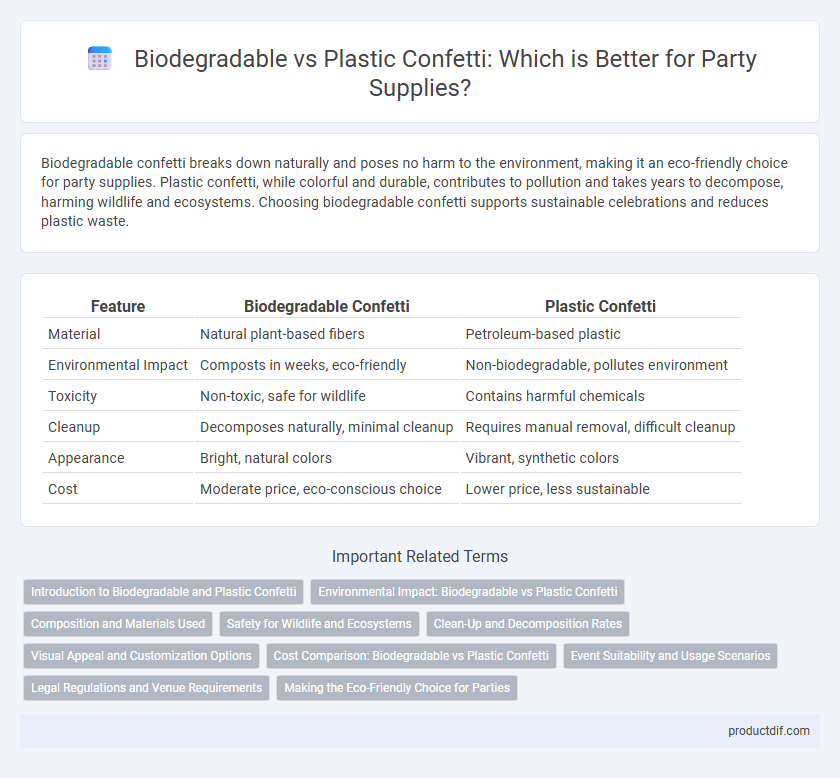Biodegradable confetti breaks down naturally and poses no harm to the environment, making it an eco-friendly choice for party supplies. Plastic confetti, while colorful and durable, contributes to pollution and takes years to decompose, harming wildlife and ecosystems. Choosing biodegradable confetti supports sustainable celebrations and reduces plastic waste.
Table of Comparison
| Feature | Biodegradable Confetti | Plastic Confetti |
|---|---|---|
| Material | Natural plant-based fibers | Petroleum-based plastic |
| Environmental Impact | Composts in weeks, eco-friendly | Non-biodegradable, pollutes environment |
| Toxicity | Non-toxic, safe for wildlife | Contains harmful chemicals |
| Cleanup | Decomposes naturally, minimal cleanup | Requires manual removal, difficult cleanup |
| Appearance | Bright, natural colors | Vibrant, synthetic colors |
| Cost | Moderate price, eco-conscious choice | Lower price, less sustainable |
Introduction to Biodegradable and Plastic Confetti
Biodegradable confetti is made from natural materials such as rice paper or dried flower petals that decompose quickly and reduce environmental impact. Plastic confetti consists of small, non-biodegradable pieces made from synthetic polymers that persist in the environment, contributing to pollution. Choosing biodegradable confetti supports eco-friendly celebrations by minimizing landfill waste and protecting wildlife.
Environmental Impact: Biodegradable vs Plastic Confetti
Biodegradable confetti breaks down naturally within weeks, reducing environmental pollution and minimizing harm to wildlife, unlike plastic confetti which can persist for years, contributing to microplastic contamination in ecosystems. Plastic confetti often ends up in oceans and soil, posing long-term hazards to marine life and birds that may ingest these non-degradable materials. Choosing biodegradable confetti supports eco-friendly celebrations by lowering carbon footprint and promoting sustainability compared to traditional plastic alternatives.
Composition and Materials Used
Biodegradable confetti is made from natural materials such as rice paper, cellulose, or dried flower petals, ensuring it breaks down quickly and safely in the environment. Plastic confetti consists of synthetic polymers like polyethylene or polypropylene, which do not decompose easily and contribute to long-term pollution. Choosing biodegradable confetti supports eco-friendly celebrations by minimizing waste and reducing harm to wildlife and ecosystems.
Safety for Wildlife and Ecosystems
Biodegradable confetti decomposes naturally, minimizing harm to wildlife and reducing pollution in ecosystems, unlike plastic confetti which poses ingestion risks and long-term environmental contamination. Wildlife often mistake plastic confetti for food, leading to digestive blockages, while biodegradable options break down into non-toxic components. Choosing biodegradable confetti supports safer celebrations by preserving ecological balance and preventing plastic waste accumulation in natural habitats.
Clean-Up and Decomposition Rates
Biodegradable confetti breaks down naturally within weeks when exposed to moisture and sunlight, significantly reducing clean-up time and environmental impact compared to plastic confetti, which can linger for years and create persistent litter. Plastic confetti requires extensive manual removal to prevent pollution in waterways and harm to wildlife, making post-party clean-up labor-intensive and environmentally unfriendly. Selecting biodegradable confetti supports eco-conscious party supplies by minimizing both clean-up efforts and decomposition periods.
Visual Appeal and Customization Options
Biodegradable confetti offers vibrant colors and a natural texture that enhances outdoor celebrations while providing eco-friendly customization through various shapes and plant-based materials. Plastic confetti delivers brighter, more uniform colors with glossy finishes, allowing for a broader range of custom shapes and printed designs ideal for indoor or controlled environments. Both types provide unique visual appeals, but biodegradable options prioritize sustainability alongside aesthetic customization tailored for environmentally conscious events.
Cost Comparison: Biodegradable vs Plastic Confetti
Biodegradable confetti typically costs more upfront than plastic confetti due to eco-friendly materials and sustainable production processes. Plastic confetti, often cheaper and mass-produced, can incur hidden environmental cleanup costs and potential fines for non-biodegradable waste. Evaluating true cost requires factoring in environmental impact and disposal regulations alongside initial purchase price.
Event Suitability and Usage Scenarios
Biodegradable confetti is ideal for outdoor events and eco-conscious celebrations, dissolving naturally without harming the environment. Plastic confetti, while vibrant and durable, suits indoor parties or venues where easy cleanup is essential but poses environmental risks. Choosing between them depends on event location, cleanup capabilities, and sustainability priorities.
Legal Regulations and Venue Requirements
Biodegradable confetti complies with stricter environmental regulations and is often mandated by venues aiming to reduce ecological impact, unlike plastic confetti which is frequently prohibited due to its non-degradable nature. Many event spaces enforce policies requiring biodegradable alternatives to minimize cleanup costs and environmental harm. Understanding local legal restrictions ensures event planners select confetti types that meet venue-specific sustainability standards and avoid fines.
Making the Eco-Friendly Choice for Parties
Biodegradable confetti, made from natural materials like rice paper or dried flowers, decomposes quickly and reduces environmental impact compared to traditional plastic confetti, which lingers as harmful microplastics. Choosing eco-friendly biodegradable confetti for parties supports sustainable celebrations by minimizing pollution and protecting wildlife. This small switch helps hosts create vibrant, joyful events while prioritizing environmental responsibility.
Biodegradable Confetti vs Plastic Confetti Infographic

 productdif.com
productdif.com